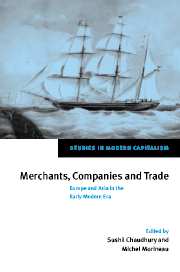Book contents
- Frontmatter
- Contents
- List of contributors
- Preface
- Introduction
- Part I Asia, especially India, around 1500
- Part II Routes, markets and merchants
- Part III European presence in Asia
- 8 The Portuguese and the Dutch in Asian maritime trade: a comparative analysis
- 9 Competition or collaboration? Relations between the Dutch East India Company and Indian merchants around 1680
- 10 The French India Company and its trade in the eighteenth century
- 11 Sweden and India in the eighteenth century: Sweden's difficulty in gaining access to a crowded market
- 12 The ambitions of the Austrian Empire with reference to East India during the last quarter of the eighteenth century
- Part IV Implications of trade: Asia and Europe
- Index
12 - The ambitions of the Austrian Empire with reference to East India during the last quarter of the eighteenth century
Published online by Cambridge University Press: 02 December 2009
- Frontmatter
- Contents
- List of contributors
- Preface
- Introduction
- Part I Asia, especially India, around 1500
- Part II Routes, markets and merchants
- Part III European presence in Asia
- 8 The Portuguese and the Dutch in Asian maritime trade: a comparative analysis
- 9 Competition or collaboration? Relations between the Dutch East India Company and Indian merchants around 1680
- 10 The French India Company and its trade in the eighteenth century
- 11 Sweden and India in the eighteenth century: Sweden's difficulty in gaining access to a crowded market
- 12 The ambitions of the Austrian Empire with reference to East India during the last quarter of the eighteenth century
- Part IV Implications of trade: Asia and Europe
- Index
Summary
In spite of the abrogation of the Ostend Company, the Southern Netherlands were still very interested in trading with the Far East. In 1723, the Ostend Company was issued a patent for a trade monopoly to Africa and to East and West India, accompanied by the usual royal prerogatives such as tax facilities and sovereign rights in respect of foreign monarchs. The Company prospered and was a big success. Proceeding from the Southern Netherlands it took over the trade factories which were previously established by private outfits at Cabelon near Pondicherry, and it founded a new lodge at Banquibazar in Bengal with four outposts located in the delta of the Ganges. The trade with China proved extremely profitable and became far more important than the trade to Bengal, which was exposed to fierce international competition and to an unstable political and climatic situation characteristic of Bengal. Furthermore, this trade was burdened by the maintenance costs of the imperial factory as well as by the loss of at least three ships. Notwithstanding a less profitable Bengal trade, the Ostend Company was too successful to be tolerated by foreign competitors. Consequently the Ostend Company was doomed to disappear. In 1731, the Company's privilege was permanently withdrawn. The dissolution of the Ostend Company served as a peace-offering during the cold war between Austria and the anti-Habsburg Alliance. The Company was forced to close down; however, the liquidation procedures kepy lingering on, in the hope that the Company could be rescued.
- Type
- Chapter
- Information
- Merchants, Companies and TradeEurope and Asia in the Early Modern Era, pp. 227 - 240Publisher: Cambridge University PressPrint publication year: 1999
- 2
- Cited by



